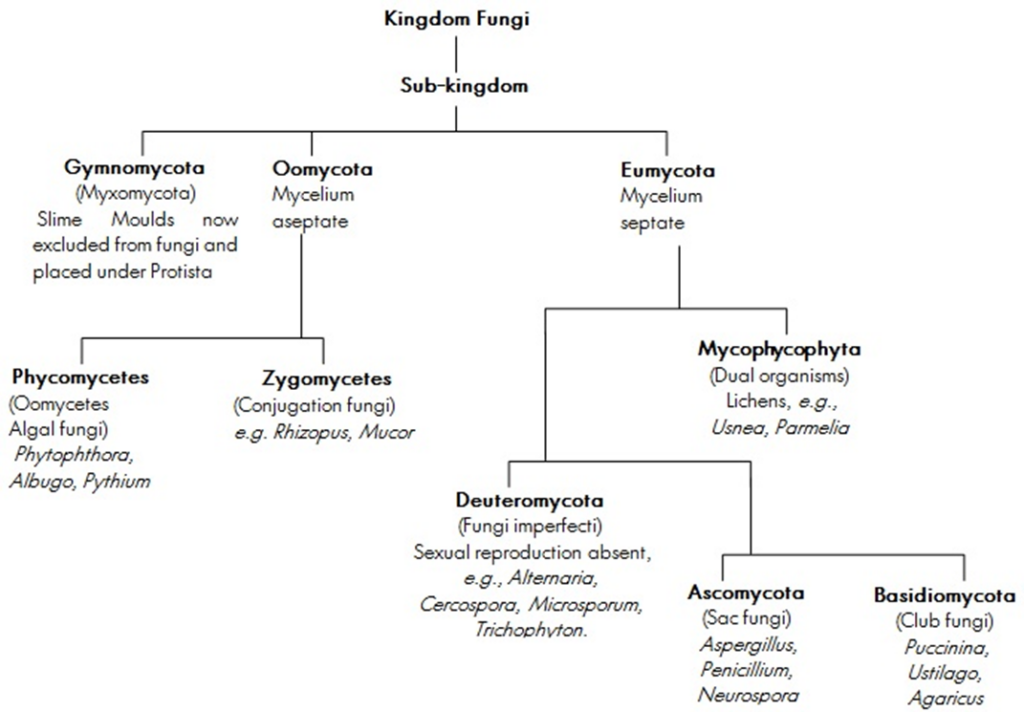INTRODUCTION
- A typical fungal cell is eukaryotic and consists of a true nucleus and membrane-bound organelles.
- The kingdom Fungi comprise an enormous variety of living organisms which are generally referred to as Ascomycota, or true Fungi.
- Organisms such as Edible mushrooms, yeasts, black molds, and Penicilliumnotatum, are all members of the kingdom Fungi, which have its place in the domain Eukarya.
- Fungi are more closely associated to animals than plants.
SALIENT FEATURES OF FUNGI
- Fungi are eukaryotic organisms, have a true nucleus enclosed in nuclear membrane and membrane bound organelles.
- Fungal cells are surrounded by cell walls. Their cell wall is made up of chitin.
- Fungi undergo the phenomenon of alternation of generation. They comprise both haploid and diploid stages in their life cycle.
- Hyphae (singular hypa) are the branching filamentous structures of a fungus that bear the spores. Hyphae can grow and result in a network called a mycelium.
- Reproduction: Fungi can reproduce both sexually and asexually. Both processes involve spore formation. Sexual spores are referred to as Oospores, Zygospores, Ascospores, Basidiospores, etc. Asexual spores include Sporangiospores, Aplanospores, Zoospores, Conidia, etc.
CLASSIFICATION OF FUNGI
REPRODUCTION IN FUNGI
- Fungi reproduce by both sexual an asexual means.
ASEXUAL REPRODUCTION
Fungi reproduce asexually by following methods
- Fragmentation
- Budding
- Spores
FRAGMENTATION
- An asexual process in multi-cellular organisms in which the organism give rise to offspring by splitting into fragments.
- During Fragmentation, a fungal mycelium splits into pieces and the component grows into a separate mycelium. Fragments of hyphae can grow new colonies.
BUDDING
- During budding, an outgrowth forms on the side of the cell. The nucleus of the parent cell divides with the process of mitosis. One of the daughter nuclei migrates to the bud while the other remains in the parent cell.
- The bud then detaches itself from the parent cell and forms a fully functional daughter cell.
- This type of asexual reproduction is observed in yeast and some filamentous fungi.
PRODUCTION OF SPORES
- Asexual spores are released by one parent only and are genetically identical to that parent. Spores help fungi to expand their distribution and colonize new environments.
- They may be released from the parent into a special reproductive sac called a sporangium.
SEXUAL REPRODUCTION
- Sexual reproduction is the cause of genetic variation in a population of fungi.
- There are two mating types;
- Homothallic
- Heterothallic
- When both mating types occur in the same mycelium, it is called homothallic, or self-fertile. Heterothallic mycelia involve two different, but compatible, mycelia to reproduce sexually.
- The sexual reproduction of fungi occurs in following three stages:
- Plasmogamy: During Plasmogamy, two haploid cells fuse and form a dikaryotic stage where two haploid nuclei coexist in a single cell.
- Karyogamy: During karyogamy (“nuclear marriage”), the haploid nuclei fuse to produce a diploid zygote nucleus.
- Meiosis: meiosis occurs in the gametangia organs, where gametes of different mating types are produced. During this stage, spores are dispersed into the environment.
PHYCOMYCETES
- The members of Phycometes are found in the aquatic habitats and on decaying woods in moist and damp places.
- The mycelium of this type of Fungi is aseptate and coenocytic.
- zygospores are formed by two gametes. The gametes can be isogamous or anisogamous/ oogamous.
- Examples: Rhizopus, Albugo
ASCOMYCETES
- The ascomycetes are also known as sac fungi. They can be either unicellular or multi-cellular.
- They are saprophytic, decomposers, parasitic or coprophilous means grows on dung.
- The mycelium is branched and separate.
- Conidia are the asexual pores produced on the conidiophores, which is known as special mycelium.
- The sexual spores are called ascoposres which are produced in asci, means singular ascus. The asci are arranged on ascocarps.
- Examples: Aspergillus, Neurospora, Claviceps
Unicellular ascomycetes: Sacharomyces (Yeast), Multicellular ascomycetes: Penicillium.
BASIDIOMYCETES
- The members of Basidiomycetes grow in soil, on logs and tree stumps and in living plant bodies as parasites.
- The mycelium is branched and septate. Though the asexual spores are not found, but fragmentation is common.
- The sex organs are absent, though plasmogamy is brought about by fusion of two somatic cells or two vegetative cells of genotypes or vegetative strains. This gives rise to basidium.
- Karyogamy and meiosis takes place in the basidium producing four basidiospores.
- Examples: Agaricus, Puccinia, Ustilago
DEUTEROMYCETES
- They are known as imperfect fungi as the vegetative or asecual phases are only known in this case of the fungi.
- At first when it was identified the sexual forms were discovered but the asexual and vegetative phases have been given one name. later though, the linkage was established and the fungi were moved out of dueteromycetes.
- They reproduce only by asexual mode of reproduction called conidia.
- The mycelium is branched and septate.
- Examples: Trichoderma, Alternaria, Colletotrichum
IMPORTANCE AND USES OF FUNGI
- Fungi are important decomposers in most ecosystems.
- Fungi are responsible for most of the recycling in the environment which returns dead material to the soil in a form in which it can be reused.
- Fungi, as food, are agents of fermentation in the production of bread, cheese, alcoholic beverages, and numerous other food preparations.
- Secondary metabolites of fungi such as antibiotics and anticoagulants are utilized as medicines.
- Fungi are used as model organisms for the study of eukaryotic genetics and metabolism.


Responses